Sunday 25 July 2004
British Royal Flags and Standards
A red, gold and blue flag flies on the mast at Buckingham Palace; a little
version of it flutters on the front of the car as the Queen drives by, and a similar flag,
but with added bits and pieces, flies above Clarence House. Welcome to the world of
British and royal standards and flags.
It’s a world with two major mis-nomenclatures. The Royal Standard is not a standard,
and the Union Jack is not a jack (except when it flies from the jack staff of a ship).
More of the Union Jack later.
In heraldic language, the Royal Standard is actually a banner - a square or rectangular
flag depicting the same design that appears on the shield (and only the shield) of a
person’s coat of arms. A heraldic standard is a long, tapering flag containing either
a national flag (the cross of St .George in England) or the owner’s arms next to the
staff, and the rest of the flag divided into the main colours from the coat of arms and
bearing the owner’s heraldic crest, motto and badge or badges.
|
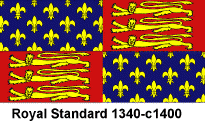 The first English royal standard or banner
of the "heraldic era" belonged to Richard the Lionheart, who adopted the arms of
England which survive to this day. It has three gold lions on a red background, walking
with their heads turned to face out from the shield, or, in heraldic language "Gules,
three lions passant guardant in pale Or." This remained the arms of English kings
until 1340, when Edward III asserted his claim to the French throne and added the French
arms of gold fleur-de-lys scattered on a blue background. Because France was the senior
kingdom, its arms took pride of place in the first quarter (top left) and was repeated in
the fourth (bottom right). The first English royal standard or banner
of the "heraldic era" belonged to Richard the Lionheart, who adopted the arms of
England which survive to this day. It has three gold lions on a red background, walking
with their heads turned to face out from the shield, or, in heraldic language "Gules,
three lions passant guardant in pale Or." This remained the arms of English kings
until 1340, when Edward III asserted his claim to the French throne and added the French
arms of gold fleur-de-lys scattered on a blue background. Because France was the senior
kingdom, its arms took pride of place in the first quarter (top left) and was repeated in
the fourth (bottom right). |
|
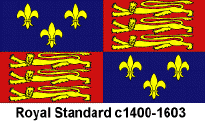 In the early 15th century, the French king reduced
the number of fleur-de-lys from an indeterminate number (usually around 9) to three, and
Henry IV of England followed suit. In the early 15th century, the French king reduced
the number of fleur-de-lys from an indeterminate number (usually around 9) to three, and
Henry IV of England followed suit.
|
|
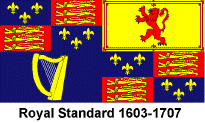 The royal standard remained unchanged until the union
of the crowns of England and Scotland in 1603, when James I and VI quartered the
English/French flag with that of Scotland and the gold harp of Ireland. This standard
remained unchanged until England and Scotland were united into a single country in 1707,
except during the reign of William III, when Dutch arms were added on a small shield in
the centre. The royal standard remained unchanged until the union
of the crowns of England and Scotland in 1603, when James I and VI quartered the
English/French flag with that of Scotland and the gold harp of Ireland. This standard
remained unchanged until England and Scotland were united into a single country in 1707,
except during the reign of William III, when Dutch arms were added on a small shield in
the centre. |
|
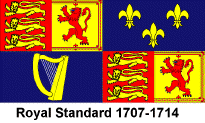 As a result of the Treaty of Union in 1707, the arms
of England and Scotland were impaled (placed side by side) in the first and fourth
quarters, and France was demoted to the second quarter. When George I, Elector of Hanover,
became King of Great Britain in 1714, arms representing his German dominions were placed
in the fourth quarter. The union of Great Britain with Ireland in 1801 led to a
rearrangement of the arms and standard. The empty claim to the throne of France (and with
it the French arms), was dropped and the standard was arranged with England in the first
and fourth quarters, Scotland in the second, and Ireland in the third. The arms of
Hanover, surmounted by an electoral bonnet, were placed on a shield in the centre. Hanover
became a kingdom in 1816, and the bonnet was replaced by a German royal crown. As a result of the Treaty of Union in 1707, the arms
of England and Scotland were impaled (placed side by side) in the first and fourth
quarters, and France was demoted to the second quarter. When George I, Elector of Hanover,
became King of Great Britain in 1714, arms representing his German dominions were placed
in the fourth quarter. The union of Great Britain with Ireland in 1801 led to a
rearrangement of the arms and standard. The empty claim to the throne of France (and with
it the French arms), was dropped and the standard was arranged with England in the first
and fourth quarters, Scotland in the second, and Ireland in the third. The arms of
Hanover, surmounted by an electoral bonnet, were placed on a shield in the centre. Hanover
became a kingdom in 1816, and the bonnet was replaced by a German royal crown. |
|
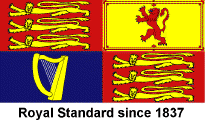 Queen Victoria inherited the crown of Great Britain in
1837, but not that of Hanover, because German succession laws barred women from the
throne. The arms and crown of Hanover disappeared from the royal standard, which has
remained unchanged since. Queen Victoria inherited the crown of Great Britain in
1837, but not that of Hanover, because German succession laws barred women from the
throne. The arms and crown of Hanover disappeared from the royal standard, which has
remained unchanged since.
|
|
 Developments in the Commonwealth led to a series of
new personal flags for the Queen. It was no longer thought appropriate for her to fly her
standard as British sovereign when acting in a different capacity. When travelling in
Commonwealth countries of which she is not Queen, Her Majesty now flies a personal flag as
Head of the Commonwealth, which is square with a blue background and a design of a gold
crowned letter "E" surrounded by a chaplet of roses. Developments in the Commonwealth led to a series of
new personal flags for the Queen. It was no longer thought appropriate for her to fly her
standard as British sovereign when acting in a different capacity. When travelling in
Commonwealth countries of which she is not Queen, Her Majesty now flies a personal flag as
Head of the Commonwealth, which is square with a blue background and a design of a gold
crowned letter "E" surrounded by a chaplet of roses. |
|
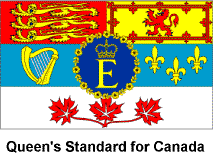 In those realms of which she is sovereign, she uses a
flag consisting of a banner of the country's arms with the same design in the centre In those realms of which she is sovereign, she uses a
flag consisting of a banner of the country's arms with the same design in the centre |
|
In 1964 Britain's defence administration was reformed and the office of
Lord High Admiral was restored, having been in commission for most of the last 250 years
(being “in commission” meant that its authority was vested in a board of Lords
of the Admiralty, instead of in an individual). The title went to Her Majesty, and with it
yet another flag - the Admiralty flag of a gold anchor on red. The flag is flown on naval
vessels when she is on board, along with the Royal Standard.
Officially, the United Kingdom has no national flag! The Union Flag is yet another royal
banner, although its use by citizens has been sanctioned by the Crown. Its distinctive
design is a combination of three other flags, representing England, Scotland and Ireland. |
|
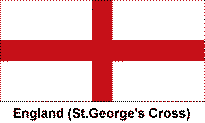 St. George became England's patron saint during the late
thirteenth century, and English soldiers probably first used the red cross during the
Welsh wars of Edward I. St. George became England's patron saint during the late
thirteenth century, and English soldiers probably first used the red cross during the
Welsh wars of Edward I. |
|
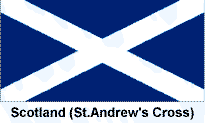 Scotland started flying the cross of it's own patron
saint, Andrew, at around the same time. This is white on blue field, but is a saltire
(x-shaped), representing the tradition that St. Andrew was crucified on such a cross,
having pleaded that he was unworthy of dying on a vertical cross like Jesus. Scotland started flying the cross of it's own patron
saint, Andrew, at around the same time. This is white on blue field, but is a saltire
(x-shaped), representing the tradition that St. Andrew was crucified on such a cross,
having pleaded that he was unworthy of dying on a vertical cross like Jesus. |
|
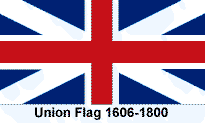 In 1606, James VI and I wanted a flag to represent
both his kingdoms, and ideas for a design combining the two crosses were put forward. The
chosen design placed the English red cross on top of the Scottish flag, but with a white
border so that it stands out from the blue background. This flag was used until the union
with Ireland in 1801, when a red saltire was added to represent Ireland. In 1606, James VI and I wanted a flag to represent
both his kingdoms, and ideas for a design combining the two crosses were put forward. The
chosen design placed the English red cross on top of the Scottish flag, but with a white
border so that it stands out from the blue background. This flag was used until the union
with Ireland in 1801, when a red saltire was added to represent Ireland. |
|
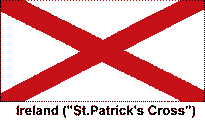 This is commonly referred to as a St. Patrick’s
Cross, but it is not. It was the arms of the FitzGeralds, Dukes of Leinster, a leading
Anglo-Irish family, and it was first used in a national context in the insignia of the
Order of St. Patrick in 1783. This is commonly referred to as a St. Patrick’s
Cross, but it is not. It was the arms of the FitzGeralds, Dukes of Leinster, a leading
Anglo-Irish family, and it was first used in a national context in the insignia of the
Order of St. Patrick in 1783. |
|
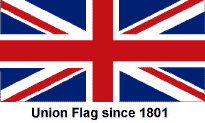 Conveniently, it fitted nicely on the existing Union
Flag. It was not simply superimposed onto the Scottish saltire, though. Instead, a complex
arrangement was made in which the Scottish white appears above the Irish red on the staff
side of the flag, while the two colours are transposed in the fly, and the pair of
saltires are bordered in more white. If the red saltire had simply been placed over the
white, it might have simply appeared to be a red saltire with a white border, rather than
two saltires combined. Conveniently, it fitted nicely on the existing Union
Flag. It was not simply superimposed onto the Scottish saltire, though. Instead, a complex
arrangement was made in which the Scottish white appears above the Irish red on the staff
side of the flag, while the two colours are transposed in the fly, and the pair of
saltires are bordered in more white. If the red saltire had simply been placed over the
white, it might have simply appeared to be a red saltire with a white border, rather than
two saltires combined. |
|
The Queen is not the only member of the royal family to have personal
flags. The sovereign’s consort, former consorts and children of a sovereign each fly
a distinctive flag which is a banner of their personal arms. For younger children their
arms are the same as the Queen’s, but with a white three-pointed “label”
along the top, bearing a distinctive badge on one or more of the points.
The Prince of Wales’s label is plain, but has the arms of the ancient princes of
Wales on a shield in the centre of his standard, surmounted by his coronet. He also has
personal standards for use in Wales and Scotland.
Queen Victoria’s children and grandchildren added a shield of the arms of Saxony in
the centre, representing their Saxe-Coburg inheritance from Prince Albert. This was
removed when all German names and titles were done away with in 1917, and the practice was
not repeated for Prince Philip’s children. Prince Philip’s own standard is
entirely different, although still quartered, bearing the arms of Greece, Denmark,
Mountbatten and Edinburgh. |
|
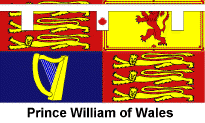 Other princes and princesses fly a standard with
the royal arms in an ermine border. This was the standard seen on the coffin of Diana,
Princess of Wales during her funeral. Other princes and princesses fly a standard with
the royal arms in an ermine border. This was the standard seen on the coffin of Diana,
Princess of Wales during her funeral.
The rules governing the use of the Royal Standard were tightened during the reign of
Edward VII. The standard represents the sovereign personally, and is to be flown only on a
building or vessel when the King/Queen is present in the building; never, for example,
when the sovereign is only passing by. Because it is the personal standard of a living
sovereign, it is never flown at half-mast. If more than one member of the royal family is
present, the standard of the highest ranking member is flown.
|
The standards are intricately connected with royal heraldry, which is a more complex
subject. More of that another time!
- Paul James
|
 The Unofficial British Royal
Family Pages
The Unofficial British Royal
Family Pages


